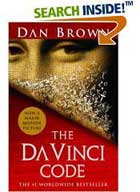
& The Story According to Bart Ehrman
The Da Vinci Code (Paperback)
by Dan Brown
Amazon.com
With The Da Vinci Code, Dan Brown masterfully concocts an intelligent and lucid thriller that marries the gusto of an international murder mystery with a collection of fascinating esoteria culled from 2,000 years of Western history.
A murder in the silent after-hour halls of the Louvre museum reveals a sinister plot to uncover a secret that has been protected by a clandestine society since the days of Christ. The victim is a high-ranking agent of this ancient society who, in the moments before his death, manages to leave gruesome clues at the scene that only his granddaughter, noted cryptographer Sophie Neveu, and Robert Langdon, a famed symbologist, can untangle. The duo become both suspects and detectives searching for not only Neveu's grandfather's murderer but also the stunning secret of the ages he was charged to protect.
LISTEN to Dan Brown about theThe Da Vinci Code: Interview by John Walters
The Official Site: Dan Brown.com
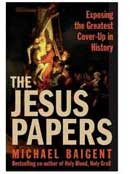 The Jesus Papers : Exposing the Greatest Cover-Up
The Jesus Papers : Exposing the Greatest Cover-Up
in History (Hardcover) by Michael Baigent
What if everything you think you know about Jesus is wrong? In The Jesus Papers, Michael Baigent reveals the truth about Jesus's life and crucifixion. Despite -- or rather because of -- all the celebration and veneration that have surrounded the figure of Jesus for centuries, Baigent asserts that Jesus and the circumstances leading to his death have been heavily mythologized.
As a religious historian and a leading expert in the field of arcane knowledge, Baigent has unequaled access to hidden archives, secret societies, Masonic records, and the private collections of antiquities traders and their moneyed clients. Using that access to full advantage, Baigent explores the religious and political climate in which Jesus was born and raised, examining not only the conflicts between the Romans and the Jews, but the strife within the different factions of the Jewish Zealot movement. He chronicles the migrations of Jesus's family, his subsequent exposure to other cultures, and the events, teachings, and influences that were most likely to have shaped his early years. Baigent also uncovers the inconsistencies and biases in the accounts of the major historians of Jesus's time, including Josephus, Pliny, and Tacitus. The enduring influence of these accounts in forming our most common conceptions of Jesus reveals that spin is not a new phenomenon.
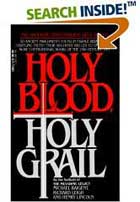 Holy Blood, Holy Grail (Paperback) by Michael Baigent, Richard Leigh, Henry Lincoln
Holy Blood, Holy Grail (Paperback) by Michael Baigent, Richard Leigh, Henry Lincoln
"We believed at first that we were dealing with a strictly local mystery-one confined to a village in the south of France..."
Amazon.com
Michael Baigent, Henry Lincoln, and Richard Leigh, authors of The Messianic Legacy, spent over 10 years on their own kind of quest for the Holy Grail, into the secretive history of early France. What they found, researched with the tenacity and attention to detail that befits any great quest, is a tangled and intricate story of politics and faith that reads like a mystery novel. It is the story of the Knights Templar, and a behind-the-scenes society called the Prieure de Sion, and its involvement in reinstating descendants of the Merovingian bloodline into political power. Why? The authors of Holy Blood, Holy Grail assert that their explorations into early history ultimately reveal that Jesus may not have died on the cross, but lived to marry and father children whose bloodline continues today. The authors' point here is not to compromise or to demean Jesus, but to offer another, more complete perspective of Jesus as God's incarnation in man. The power of this secret, which has been carefully guarded for hundreds of years, has sparked much controversy. For all the sensationalism and hoopla surrounding Holy Blood, Holy Grail and the alternate history that it outlines, the authors are careful to keep their perspective and sense of skepticism alive in its pages, explaining carefully and clearly how they came to draw such combustible conclusions. --Jodie Buller
Book Description
Is the traditional, accepted view of the life of Christ in some way incomplete?
• Is it possible Christ did not die on the cross?
• Is it possible Jesus was married, a father, and that his bloodline still exists?
• Is it possible that parchments found in the South of France a century ago reveal one of the best-kept secrets of Christendom?
• Is it possible that these parchments contain the very heart of the mystery of the Holy Grail?
According to the authors of this extraordinarily provocative, meticulously researched book, not only are these things possible — they are probably true! so revolutionary, so original, so convincing, that the most faithful Christians will be moved; here is the book that has sparked worldwide controversey.
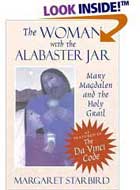 The Woman with the Alabaster Jar:
The Woman with the Alabaster Jar:
Mary Magdalen and the Holy Grail (Paperback)
by Margaret Starbird
ReviewNexus : Book Description
Was Jesus Married? Margaret Starbird’s theological beliefs were profoundly shaken when she read Holy Blood, Holy Grail, a book that dared to suggest that Jesus Christ was married and that his descendents carried his bloodline to Western Europe. Shocked by such heresy, this Roman Catholic scholar set out to refute it. Instead, as she researched the subject, she found new and compelling evidence for the existence of the bride of Jesus—the same enigmatic woman who anointed him with precious unguent from her “alabaster jar”—as well as for the hidden “Church of the Grail.” Starbird was becoming convinced that the wife of Jesus was indeed the “Sangraal,” the bearer of the holy bloodline—the mythical chalice, the Holy Grail. This work of consummate scholarship is a detailed summary of the author’s difficult and often painful quest for truth. Starbird draws her conclusions form an extensive study of history, heraldry, symbolism, medieval art, mythology, psychology, and the bible itself. This provocative book is bound to ignite conversation and controversy.
Two Books: The Story According to Bart Ehrman
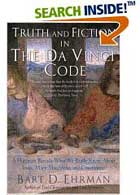 Truth and Fiction in The Da Vinci Code : A Historian Reveals
Truth and Fiction in The Da Vinci Code : A Historian Reveals
What We Really Know about Jesus, Mary Magdalene,
and Constantine (Paperback) by Bart D. Ehrman
"Despite the intricacies of its plots and subplots, The Da Vinci Code is essentially a story of right versus wrong...
From Publishers Weekly
Ehrman, chair of religious studies at UNC-Chapel Hill, has written widely on the subject of early Christian documents and the formation of the biblical canon. While acknowledging that Dan Brown's The Da Vinci Code is an exciting mystery novel, Ehrman questions some of its historical claims. Focusing on 10 areas of concern, including the role Constantine played in the formation of the both the church and the Bible and the evidence for Jesus' personal involvement with Mary Magdalene, Ehrman reviews the historical record and demonstrates that Brown's history behind the mystery is seriously flawed. Ehrman is not concerned with theology; he has no interest beyond that of the professional historian who wants to arm the everyday reader with sound research and helpful historical perspective. His is a documentary approach, avoiding speculation and theory. This tone distinguishes the book from many other responses to Brown's novel that uphold a particular theological agenda. Ultimately, Ehrman believes that readers should not try to learn history from speculative fiction. This is a very readable treatment of some difficult themes, such as the reasons for the exclusion of some early gospels from the canon and the enormous influence of recent archeological discoveries. Readers at every level will appreciate this book.
Copyright © Reed Business Information, a division of Reed Elsevier Inc. All rights reserved. --This text refers to the Hardcover edition.
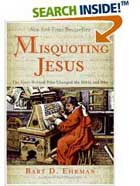 Misquoting Jesus : The Story Behind Who Changed the Bible and Why (Hardcover)
Misquoting Jesus : The Story Behind Who Changed the Bible and Why (Hardcover)
by Bart Ehrman
"More than almost anything I've ever written about, the subject of this book has been on my mind for the past thirty years, since I..." (more)
The popular perception of the Bible as a divinely perfect book receives scant support from Ehrman, who sees in Holy Writ ample evidence of human fallibility and ecclesiastical politics. Though himself schooled in evangelical literalism, Ehrman has come to regard his earlier faith in the inerrant inspiration of the Bible as misguided, given that the original texts have disappeared and that the extant texts available do not agree with one another. Most of the textual discrepancies, Ehrman acknowledges, matter little, but some do profoundly affect religious doctrine. To assess how ignorant or theologically manipulative scribes may have changed the biblical text, modern scholars have developed procedures for comparing diverging texts. And in language accessible to nonspecialists, Ehrman explains these procedures and their results. He further explains why textual criticism has frequently sparked intense controversy, especially among scripture-alone Protestants. In discounting not only the authenticity of existing manuscripts but also the inspiration of the original writers, Ehrman will deeply divide his readers. Although he addresses a popular audience, he undercuts the very religious attitudes that have made the Bible a popular book. Still, this is a useful overview for biblical history collections. Bryce Christensen: Copyright © American Library Association. All rights reserved
